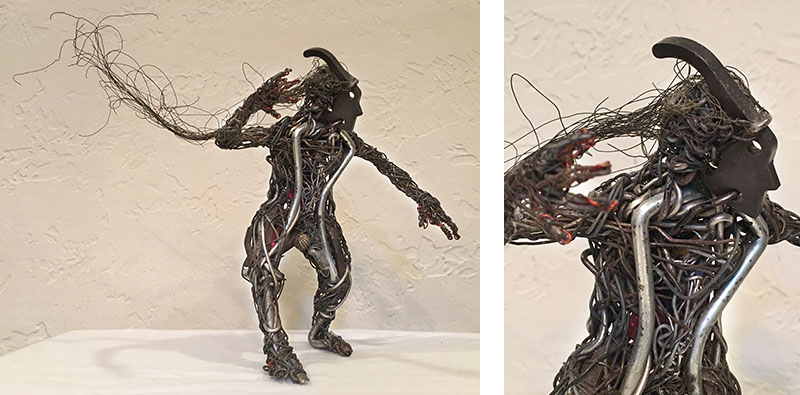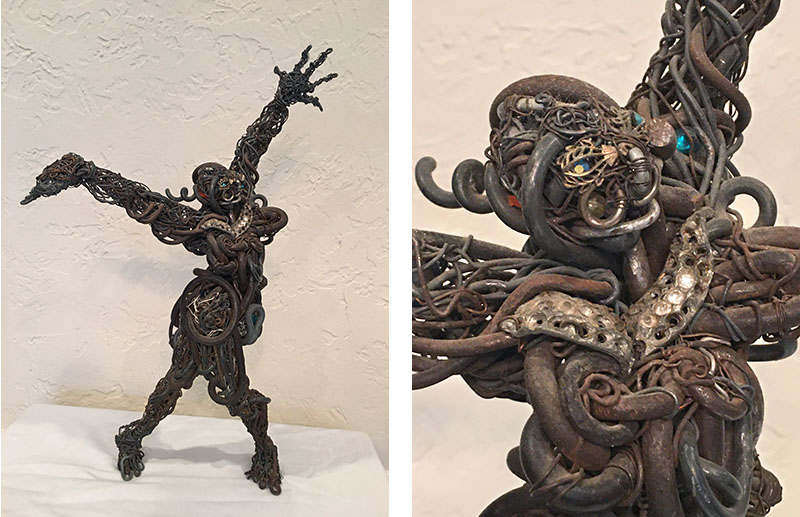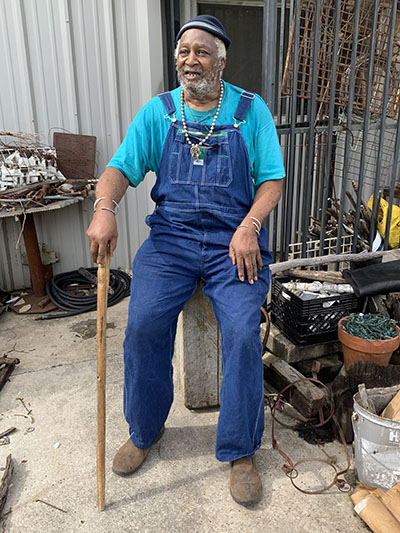Shuffle 'em up and play again

Laura Fain: Except for brief periods in Los Angeles and Phoenix, you've spent a lifetime as a Houston artist. Who inspired you in the early years?
Jesse Lott: I would have to start with Myrtle McGowan, my 8th grade art teacher at HISD. She was the architect of my concepts and principles more than anybody else. The lady showed me how to hold a pencil and how to think. This piece I'm doing right now? I'm still working on my 8th grade project! Seriously. One of the concepts she pushed was that you must realize your neighborhood as both the resource for your work and the place where you are working. You don't have to go any further than your neighborhood to find a reason to work and something to work with. She taught me that it's not good enough to learn technique—you have to develop it.
LF: When did you meet Dr. John Biggers, the legendary muralist who came to Houston in 1949 to chair the nascent art department at Texas Southern University?
JL: Myrtle McGowan brought Dr. Biggers to my school. But go back to 1957—immigration was just hitting Houston. The city built the ultra modern Kashmere High School, which still looks like a college campus. Dr. Biggers would go from high school to high school, preaching a deeper understanding of African art. We have always studied the European regimen of art from the Renaissance on. But Dr. Biggers said if we really wanted to know something, we'd have to take the initiative on our own to start at the Renaissance and go backwards. Don't go to where they are, go to where they came from. Study African art, so we would know the basis of European art. Only then would we have an understanding of the spiritual aspects of art. They did it to perform magic and healing, but also to mark punishment and redemption. The art didn't just have a visual significance. It was more than what you saw. It worked inside you as a person. Who you were, who you will be, who you are.
LF: You studied at Otis Art Institute in Los Angeles during the late 60s. Charles White, who was Dr. Biggers's mentor at the Hampton Institute, was also your advisor. White's teaching of art as a vehicle for community activism and change must have inspired you, as well as his drawings of contemporary African Americans portrayed with dignity and humanity in the face of racial injustice.
JL: Charles White is a heavy influence to get out from under. When you look at a Charles White drawing, it's kind of like listening to a Nat King Cole or Sam Cooke record and you're going to sing that song! Because Sam Cooke had a way of delivering a song that made everybody want to sound like Sam Cooke. It's the type of phrasing he did, and it's dominant—Nat King Cole is the same way, or Billie Holiday. You can hear it in the music. Somebody sings those songs and gets so close to whatever the essence is. You find yourself trying to imitate them. Same way with Charles White and line—he was a powerful line person. His technique was to actually construct a form within an illusionary space. When you look at one of his figures, it's not like, Oh, this is a figure—but that you could climb in there; you can inhabit it. You see the hand. Charles White would say, "Watch the fingernail—use the fingernail to describe the space, for the whole figure." He'd call it "staging." Or he'd set the foot in a certain way within the composition. The placement of the foot would tell you exactly what was going to happen with the whole figure.
LF: So you and Charles White were close. What has stayed with you over the decades?
JL: When I think of Charles White, the most important thing I learned was, if you find a good woman, always treat her right. He said that's the hardest lesson of life—a real good, loving relationship. No sense in throwing that away. Make a sacrifice.
LF: You were in L.A. during the Watts riots. Did you ever experience racism at Otis?
JL: There were certain biases, but I don't think it was anything systemic. Otis had maybe six black people—two business managers, four students. The majority was Jewish. Otherwise, it was a conglomerate—like a big salad. We had people from everywhere.
LF: Who was informing your visual field at the time?
JL: Ed Kienholz, of course. But I learned a lot from Mort Dimondstein, who established the School of Fine Art on La Cienega, right next door to Date Tonight Escort and Limo Service. I had a studio in Venice so, yeah, the photographer Harry Drinkwater, Keith Fitch, Marty Lubner—all those cats. Renzo Fenci, the big Italian sculptor, was the technical master. I learned a real classical approach of how to do the figure through Renzo.

LF: For years, you've been a serious domino player. Is there some mystery about dominoes—the clacking sound, the dots, the numbers?
JL: The intrigue of dominoes. The known and unknown. I can wrap it up in a neat package. It's a game in which you have opposing forces: randomness as opposed to order. You have decision making based on observation. And the observation of what occurs as opposed to the possibilities of what might occur within a limited set of circumstances. The beauty of dominoes is that you get to use your power of observation, your intuition, the laws of probability and a chance to make a play that has a direct result of gaining points, of making an advancement just like you would in an economic situation. But the game carries no real consequences. You can make as big a mistake as you want—makes no difference. Or you can make the most brilliant play and nobody will ever pay attention to it. The hand you just played? It's one of only a thousand you'll play in a lifetime. Shuffle 'em up and play again.
LF: Think about your younger self and who you are now. What are you seeking in these anxious, uncertain times? How do we find our way in an unpredictable world?
JL: Give ordinary people an opportunity to express themselves. That's what the whole country is based on—the U.S.A.—freedom of expression. But freedom of expression without the means to express yourself is meaningless. Express yourself—but don't speak, don't even walk a certain way. When the police hit the door, your rights go out the window. Let me break it down. There's a mentality that seeks to be in control. There's another mentality that wants to be out of control. The controllers want their form of order imposed at any cost: "If I don't like it, I'm not going to give you permission." See what I'm saying? We've got whole institutions based on just that.
LF: What's the message you would like to tell young artists?
JL: The fact of the matter is, you can break the expression down to EITHER/OR—and that EITHER/OR would be LOVE or HATE. Which will it be? Don't vacillate. Pick the side you want to be on. Art is the expression of human emotion. You get to a certain temperature and the steam comes out with consciousness. We call it art. If it comes out of unconsciousness, we call it crazy.
LF: What's the difference?
JL: Depends on who you are, where you are. If you're in the nut house, you're just another fool. If you're in the Museum of Fine Arts, you're a genius.

Jesse Lott lives and works in Houston, Texas.
